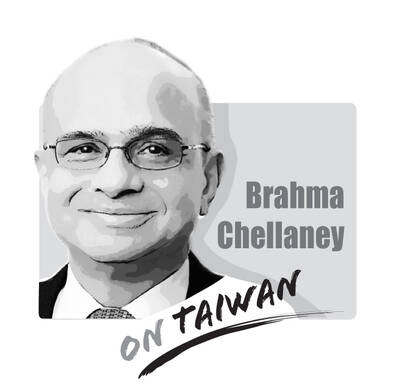During the Chinese Nationalist Party’s (KMT) National Congress on Sunday, Chen Li-hsu (陳麗旭), a delegate from Tainan, said that the National Palace Museum collection belongs to the party, as it had brought the collection when the Republic of China (ROC) government and Nationalist forces retreated to Taiwan at the end of the Chinese Civil War.
The idea is laughable — although there is little humor to it.
Underneath lie stubborn, dangerous assumptions about the KMT and its relationship with the ROC, as well as what the party seems to feel it is entitled to.
The collection belongs to the nation, under the wardenship of the government. The government is responsible only for the museum’s operations.
With democratization, the nation belongs to Taiwanese, not a political party.
When the KMT fled to Taiwan, it was inextricably linked to the ROC, as it had been in China. In Taiwan, it governed as the KMT-ROC party-state complex, but it remained, in essence, an exiled regime.
As a party-state, the KMT indulged itself in appropriation — theft — of national assets.
Democratization ended the party-state model and brought a change to the KMT’s relationship to the state, the nation and national assets, although, apparently, not its sense of entitlement.
The implication behind Chen’s statement is that national and party assets can be treated equally.
This idea is indefensible.
Artifacts are part of the national heritage and belong to the state, unless they are in private hands. The fact that the collection is conserved, stored and researched within the precincts of the National Palace Museum is a clue it belongs to the nation.
If the question was which individual had a legitimate claim to the collection, that would go back to the Qing Dynasty emperor Qianlong (乾隆). The collection in the form that fell into the hands of ROC representatives at the fall of the Qing Dynasty was, in large part, amassed by Qianlong and passed on to his dynastic successors when he died.
Unlike the KMT’s theft of Taiwanese assets to consolidate its position here as a newly exiled regime, in moving the cream of the imperial collection stored in Nanjing to Taiwan in the waning days of the Chinese Civil War, the party was legitimately saving national, historic treasures from the destruction of war, just as the ROC government did when it removed most of the collection from Beijing in 1933 ahead of the advancing Japanese forces.
If it were determined that moving the collection across the Taiwan Strait was stealing national heritage, then a case could be made that it does not belong to the ROC or the KMT as the now-defunct representatives of China, but to the Chinese Communist Party (CCP) as the internationally recognized official representative of China.
However, the Qing Dynasty was Manchu, not Han Chinese, so the collection should be returned, according to that rather stretched argument, to neither the CCP nor the KMT, but the descendants of the Manchu dynasty.
This would deliver it into the hands of former National Security Council secretary-general King Pu-tsung (金溥聰), who is reportedly a descendant of the last Qing emperor, Puyi (溥儀).
Yet that argument would be as tenuous as Chen’s.
Behind Chen’s suggestion is the lingering, implicit assumption that the KMT still represents the ROC.
In an attempt to defend Chen’s comment, former KMT chairman Eric Chu (朱立倫) said that of course the collection belonged to the ROC and Chen was simply trying to identify the party with the ROC.
Case closed.
Recently, China launched another diplomatic offensive against Taiwan, improperly linking its “one China principle” with UN General Assembly Resolution 2758 to constrain Taiwan’s diplomatic space. After Taiwan’s presidential election on Jan. 13, China persuaded Nauru to sever diplomatic ties with Taiwan. Nauru cited Resolution 2758 in its declaration of the diplomatic break. Subsequently, during the WHO Executive Board meeting that month, Beijing rallied countries including Venezuela, Zimbabwe, Belarus, Egypt, Nicaragua, Sri Lanka, Laos, Russia, Syria and Pakistan to reiterate the “one China principle” in their statements, and assert that “Resolution 2758 has settled the status of Taiwan” to hinder Taiwan’s
Singaporean Prime Minister Lee Hsien Loong’s (李顯龍) decision to step down after 19 years and hand power to his deputy, Lawrence Wong (黃循財), on May 15 was expected — though, perhaps, not so soon. Most political analysts had been eyeing an end-of-year handover, to ensure more time for Wong to study and shadow the role, ahead of general elections that must be called by November next year. Wong — who is currently both deputy prime minister and minister of finance — would need a combination of fresh ideas, wisdom and experience as he writes the nation’s next chapter. The world that

Can US dialogue and cooperation with the communist dictatorship in Beijing help avert a Taiwan Strait crisis? Or is US President Joe Biden playing into Chinese President Xi Jinping’s (習近平) hands? With America preoccupied with the wars in Europe and the Middle East, Biden is seeking better relations with Xi’s regime. The goal is to responsibly manage US-China competition and prevent unintended conflict, thereby hoping to create greater space for the two countries to work together in areas where their interests align. The existing wars have already stretched US military resources thin, and the last thing Biden wants is yet another war.
Since the Russian invasion of Ukraine in February 2022, people have been asking if Taiwan is the next Ukraine. At a G7 meeting of national leaders in January, Japanese Prime Minister Fumio Kishida warned that Taiwan “could be the next Ukraine” if Chinese aggression is not checked. NATO Secretary-General Jens Stoltenberg has said that if Russia is not defeated, then “today, it’s Ukraine, tomorrow it can be Taiwan.” China does not like this rhetoric. Its diplomats ask people to stop saying “Ukraine today, Taiwan tomorrow.” However, the rhetoric and stated ambition of Chinese President Xi Jinping (習近平) on Taiwan shows strong parallels with